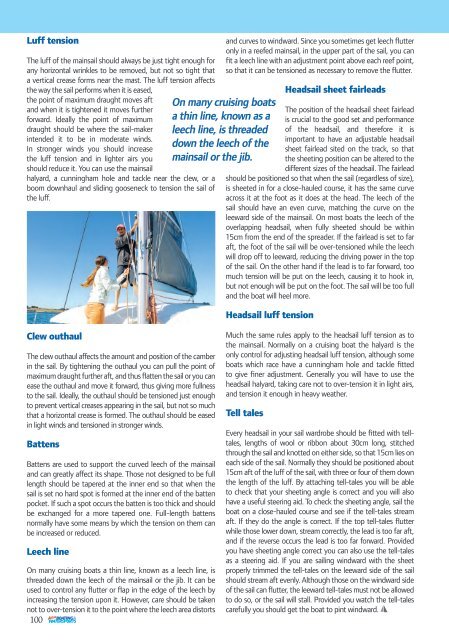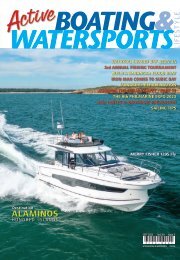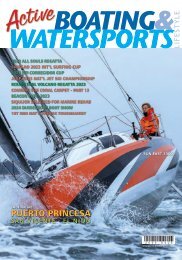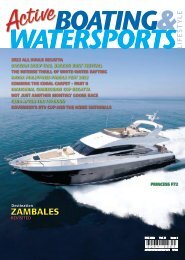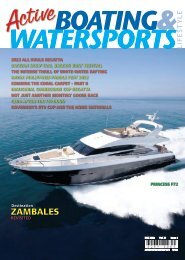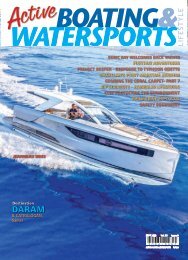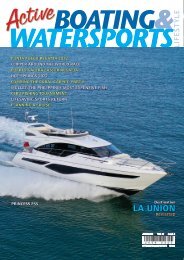ABW Sept 2023-1
You also want an ePaper? Increase the reach of your titles
YUMPU automatically turns print PDFs into web optimized ePapers that Google loves.
Luff tension<br />
The luff of the mainsail should always be just tight enough for<br />
any horizontal wrinkles to be removed, but not so tight that<br />
a vertical crease forms near the mast. The luff tension affects<br />
the way the sail performs when it is eased,<br />
the point of maximum draught moves aft<br />
and when it is tightened it moves further<br />
forward. Ideally the point of maximum<br />
draught should be where the sail-maker<br />
intended it to be in moderate winds.<br />
In stronger winds you should increase<br />
the luff tension and in lighter airs you<br />
should reduce it. You can use the mainsail<br />
halyard, a cunningham hole and tackle near the clew, or a<br />
boom downhaul and sliding gooseneck to tension the sail of<br />
the luff.<br />
On many cruising boats<br />
a thin line, known as a<br />
leech line, is threaded<br />
down the leech of the<br />
mainsail or the jib.<br />
and curves to windward. Since you sometimes get leech flutter<br />
only in a reefed mainsail, in the upper part of the sail, you can<br />
fit a leech line with an adjustment point above each reef point,<br />
so that it can be tensioned as necessary to remove the flutter.<br />
Headsail sheet fairleads<br />
The position of the headsail sheet fairlead<br />
is crucial to the good set and performance<br />
of the headsail, and therefore it is<br />
important to have an adjustable headsail<br />
sheet fairlead sited on the track, so that<br />
the sheeting position can be altered to the<br />
different sizes of the headsail. The fairlead<br />
should be positioned so that when the sail (regardless of size),<br />
is sheeted in for a close-hauled course, it has the same curve<br />
across it at the foot as it does at the head. The leech of the<br />
sail should have an even curve, matching the curve on the<br />
leeward side of the mainsail. On most boats the leech of the<br />
overlapping headsail, when fully sheeted should be within<br />
15cm from the end of the spreader. If the fairlead is set to far<br />
aft, the foot of the sail will be over-tensioned while the leech<br />
will drop off to leeward, reducing the driving power in the top<br />
of the sail. On the other hand if the lead is to far forward, too<br />
much tension will be put on the leech, causing it to hook in,<br />
but not enough will be put on the foot. The sail will be too full<br />
and the boat will heel more.<br />
Headsail luff tension<br />
Clew outhaul<br />
The clew outhaul affects the amount and position of the camber<br />
in the sail. By tightening the outhaul you can pull the point of<br />
maximum draught further aft, and thus flatten the sail or you can<br />
ease the outhaul and move it forward, thus giving more fullness<br />
to the sail. Ideally, the outhaul should be tensioned just enough<br />
to prevent vertical creases appearing in the sail, but not so much<br />
that a horizontal crease is formed. The outhaul should be eased<br />
in light winds and tensioned in stronger winds.<br />
Battens<br />
Battens are used to support the curved leech of the mainsail<br />
and can greatly affect its shape. Those not designed to be full<br />
length should be tapered at the inner end so that when the<br />
sail is set no hard spot is formed at the inner end of the batten<br />
pocket. If such a spot occurs the batten is too thick and should<br />
be exchanged for a more tapered one. Full-length battens<br />
normally have some means by which the tension on them can<br />
be increased or reduced.<br />
Leech line<br />
On many cruising boats a thin line, known as a leech line, is<br />
threaded down the leech of the mainsail or the jib. It can be<br />
used to control any flutter or flap in the edge of the leech by<br />
increasing the tension upon it. However, care should be taken<br />
not to over-tension it to the point where the leech area distorts<br />
100<br />
Much the same rules apply to the headsail luff tension as to<br />
the mainsail. Normally on a cruising boat the halyard is the<br />
only control for adjusting headsail luff tension, although some<br />
boats which race have a cunningham hole and tackle fitted<br />
to give finer adjustment. Generally you will have to use the<br />
headsail halyard, taking care not to over-tension it in light airs,<br />
and tension it enough in heavy weather.<br />
Tell tales<br />
Every headsail in your sail wardrobe should be fitted with telltales,<br />
lengths of wool or ribbon about 30cm long, stitched<br />
through the sail and knotted on either side, so that 15cm lies on<br />
each side of the sail. Normally they should be positioned about<br />
15cm aft of the luff of the sail, with three or four of them down<br />
the length of the luff. By attaching tell-tales you will be able<br />
to check that your sheeting angle is correct and you will also<br />
have a useful steering aid. To check the sheeting angle, sail the<br />
boat on a close-hauled course and see if the tell-tales stream<br />
aft. If they do the angle is correct. If the top tell-tales flutter<br />
while those lower down, stream correctly, the lead is too far aft,<br />
and if the reverse occurs the lead is too far forward. Provided<br />
you have sheeting angle correct you can also use the tell-tales<br />
as a steering aid. If you are sailing windward with the sheet<br />
properly trimmed the tell-tales on the leeward side of the sail<br />
should stream aft evenly. Although those on the windward side<br />
of the sail can flutter, the leeward tell-tales must not be allowed<br />
to do so, or the sail will stall. Provided you watch the tell-tales<br />
carefully you should get the boat to pint windward.


